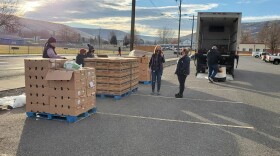-
The new space would bring four separate tribal departments under one roof, with an overarching goal to create a centralized space to celebrate and preserve Shoshone culture.
-
Seven hundred boxes of food went out into the community at the end of November, each with a package of bison meat from the reservation and chokecherry jam for elders.
-
Brendan Basham was the first-ever culinary resident at the Ucross Foundation ranch outside Buffalo. He was also the foundation’s inaugural Native American writing fellow in 2020.
-
A new national survey by the Urban Indian Health Institute is working to reveal how widespread traumatic brain injuries are among Indigenous survivors of domestic and sexual violence.
-
The ongoing federal government shutdown is putting crucial food programs – and families that rely on them – at risk.
-
At a workshop at the Wind River Tribal Conservation Summit, attendees rolled up their sleeves and tried their hand at crafting chokecherry patties on Indigenous Peoples Day.
-
Indigenous health workers strive to combat opioid crisis in New Mexico
-
The Wind River Promise Fund sets aside $250,000 to cover undergrad tuition costs and mandatory fees for full-time students. Another $2 million will be managed and invested like an endowment.
-
The film’s producers are using this recognition to ask people to reach out to their representatives to make the Not Invisible Act Commission report available after it was taken offline by the Trump administration.
-
Energize Wind River now has access to a roughly $2 million construction grant that was put on hold by the Trump administration earlier this year.
-
The office specializes in tribal collaboration and supports conservation on the Wind River Reservation.
-
The rural healthcare shortage has hit some tribal nations especially hard. One tribe in Nevada has found a solution: a doctor’s office on wheels.














